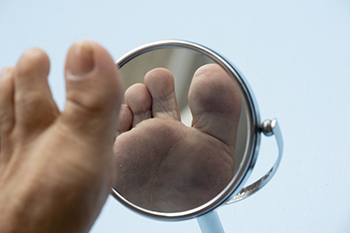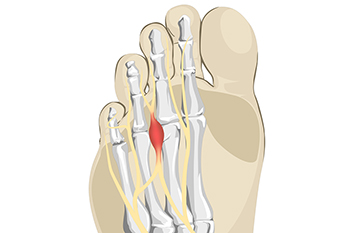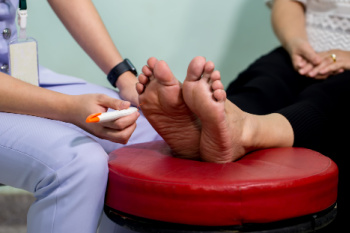Blog
Items filtered by date: February 2024
Tuesday, 27 February 2024 00:00
Treatment of Chronic Wounds on the Feet

Chronic wounds on the feet, like those from poor circulation, diabetes, pressure, or vein problems, often do not heal properly. In many cases, a podiatrist can tell what is wrong just by looking at the wound. Sometimes, they also need to check the blood flow in the legs and take a small piece of tissue for testing. Treatment for chronic wounds usually involves cleaning the wound, stopping infections, keeping it moist, and caring for the edges. Foot wounds can lead to serious health issues, and it is important to get timely treatment. If you suffer from foot wounds, it is strongly suggested that you make an appointment with a podiatrist for early intervention.
Wound care is an important part in dealing with diabetes. If you have diabetes and a foot wound or would like more information about wound care for diabetics, consult with one of the podiatrists from JE Foot & Ankle Associates. Our doctors will assess your condition and provide you with quality foot and ankle treatment.
What Is Wound Care?
Wound care is the practice of taking proper care of a wound. This can range from the smallest to the largest of wounds. While everyone can benefit from proper wound care, it is much more important for diabetics. Diabetics often suffer from poor blood circulation which causes wounds to heal much slower than they would in a non-diabetic.
What Is the Importance of Wound Care?
While it may not seem apparent with small ulcers on the foot, for diabetics, any size ulcer can become infected. Diabetics often also suffer from neuropathy, or nerve loss. This means they might not even feel when they have an ulcer on their foot. If the wound becomes severely infected, amputation may be necessary. Therefore, it is of the upmost importance to properly care for any and all foot wounds.
How to Care for Wounds
The best way to care for foot wounds is to prevent them. For diabetics, this means daily inspections of the feet for any signs of abnormalities or ulcers. It is also recommended to see a podiatrist several times a year for a foot inspection. If you do have an ulcer, run the wound under water to clear dirt from the wound; then apply antibiotic ointment to the wound and cover with a bandage. Bandages should be changed daily and keeping pressure off the wound is smart. It is advised to see a podiatrist, who can keep an eye on it.
If you have any questions, please feel free to contact one of our offices located in Fleming Island and Palm Coast, FL . We offer the newest diagnostic and treatment technologies for all your foot care needs.
Tuesday, 20 February 2024 00:00
Stretches for Healthy and Strong Feet

Maintaining healthy and strong feet is essential for overall well-being and mobility. Incorporating regular stretching exercises into your routine can help improve flexibility, reduce stiffness, and prevent common foot issues. Toe stretches, such as toe flexion and extension, help stretch the muscles and ligaments in the toes, promoting better mobility and preventing conditions like plantar fasciitis. Calf stretches, like the calf raise and wall stretch, target the Achilles tendon and calf muscles, reducing tightness and improving range of motion in the ankles and feet. Arch stretches, such as the towel stretch and golf ball roll, can alleviate discomfort and strengthen the arches of the feet, reducing the risk of conditions like flat feet. Additionally, performing ankle circles and ankle alphabet exercises can help improve ankle stability and mobility, enhancing overall foot function. If you would like information about additional specific foot stretches to practice for healthy, strong feet, it is suggested that you schedule an appointment with a podiatrist.
Exercising your feet regularly with the proper foot wear is a great way to prevent injuries and build strength. If you have any concerns about your feet, contact one of the podiatrists from JE Foot & Ankle Associates. Our doctors can provide the care you need to keep you pain-free and on your feet.
Exercise for Your Feet
Exercise for your feet can help you gain strength, mobility and flexibility in your feet. They say that strengthening your feet can be just as rewarding as strengthening another part of the body. Your feet are very important, and we often forget about them in our daily tasks. But it is because of our feet that are we able to get going and do what we need to. For those of us fortunate enough to not have any foot problems, it is an important gesture to take care of them to ensure good health in the long run.
Some foot health exercises can include ankle pumps, tip-toeing, toe rises, lifting off the floor doing reps and sets, and flexing the toes. It is best to speak with Our doctors to determine an appropriate regimen for your needs. Everyone’s needs and bodies are different, and the activities required to maintain strength in the feet vary from individual to individual.
Once you get into a routine of doing regular exercise, you may notice a difference in your feet and how strong they may become.
If you have any questions please feel free to contact one of our offices located in Fleming Island and Palm Coast, FL . We offer the newest diagnostic and treatment technologies for all your foot and ankle needs.
Tuesday, 13 February 2024 00:00
Morton’s Neuroma Explained

Foot pain, particularly sharp and stabbing sensations that ease when you stop walking and massage your foot, may indicate Morton's neuroma. Despite its intimidating name, this condition is typically harmless and very treatable. A neuroma, in simple terms, refers to the thickening of a nerve between the toes, usually between the second and third toes. Rarely, it can affect the space between the fourth or first toe. Morton's neuroma may also be called intermetatarsal neuroma, interdigital neuroma, Morton's metatarsalgia, perineural fibrosis, or entrapment neuropathy. Common symptoms can include sharp pain, numbness, tingling, burning, cramping, and a sensation of stepping on an object. Relief is often found by removing the shoe and massaging the foot. The exact cause of this nerve injury is unclear, but it may result from various factors, including foot structure, biomechanical abnormalities, and wearing ill-fitting shoes. Women aged 30 to 50 are more susceptible. Diagnosis involves a physical exam, including compression tests, and sometimes imaging such as X-rays, ultrasounds, or MRIs. To prevent Morton's neuroma, opt for well-fitting, comfortable shoes with wide-toe boxes, avoid high heels and narrow shoes, and consider orthotic inserts if needed. If you have pain in the area described above, it is suggested that you schedule an appointment with a podiatrist for a proper diagnosis and care.
Morton’s neuroma is a very uncomfortable condition to live with. If you think you have Morton’s neuroma, contact one of the podiatrists of JE Foot & Ankle Associates. Our doctors will attend to all of your foot care needs and answer any of your related questions.
Morton’s Neuroma
Morton's neuroma is a painful foot condition that commonly affects the areas between the second and third or third and fourth toe, although other areas of the foot are also susceptible. Morton’s neuroma is caused by an inflamed nerve in the foot that is being squeezed and aggravated by surrounding bones.
What Increases the Chances of Having Morton’s Neuroma?
- Ill-fitting high heels or shoes that add pressure to the toe or foot
- Jogging, running or any sport that involves constant impact to the foot
- Flat feet, bunions, and any other foot deformities
Morton’s neuroma is a very treatable condition. Orthotics and shoe inserts can often be used to alleviate the pain on the forefront of the feet. In more severe cases, corticosteroids can also be prescribed. In order to figure out the best treatment for your neuroma, it’s recommended to seek the care of a podiatrist who can diagnose your condition and provide different treatment options.
If you have any questions, please feel free to contact one of our offices located in Fleming Island and Palm Coast, FL . We offer the newest diagnostic and treatment technologies for all your foot care needs.
Tuesday, 06 February 2024 00:00
Facts About Peripheral Neuropathy

Peripheral neuropathy, commonly associated with diabetes, is nerve damage that primarily affects the extremities, especially the feet and legs. Symptoms of peripheral neuropathy include burning, tingling, numbness, pain, and weakness. These often worsen at night and lead to balance issues and difficulty walking. Peripheral neuropathy can increase the risk of foot problems, such as blisters and sores, that go unnoticed. This can result in severe infections, ulcers, or even loss of limb if left untreated. Diagnosis by a podiatrist involves medical history, physical examination, and tests like neurological exams and foot sensation assessments. Prevention entails meticulous diabetes management, regular foot care, and prompt treatment of any foot issues. Collaboration with healthcare professionals, especially a podiatrist, is vital for effective management of peripheral neuropathy. In order to improve and preserve foot health, it is suggested that you are under the care of a podiatrist who is medically trained to treat this condition.
Neuropathy
Neuropathy can be a potentially serious condition, especially if it is left undiagnosed. If you have any concerns that you may be experiencing nerve loss in your feet, consult with one of the podiatrists from JE Foot & Ankle Associates. Our doctors will assess your condition and provide you with quality foot and ankle treatment for neuropathy.
What Is Neuropathy?
Neuropathy is a condition that leads to damage to the nerves in the body. Peripheral neuropathy, or neuropathy that affects your peripheral nervous system, usually occurs in the feet. Neuropathy can be triggered by a number of different causes. Such causes include diabetes, infections, cancers, disorders, and toxic substances.
Symptoms of Neuropathy Include:
- Numbness
- Sensation loss
- Prickling and tingling sensations
- Throbbing, freezing, burning pains
- Muscle weakness
Those with diabetes are at serious risk due to being unable to feel an ulcer on their feet. Diabetics usually also suffer from poor blood circulation. This can lead to the wound not healing, infections occurring, and the limb may have to be amputated.
Treatment
To treat neuropathy in the foot, podiatrists will first diagnose the cause of the neuropathy. Figuring out the underlying cause of the neuropathy will allow the podiatrist to prescribe the best treatment, whether it be caused by diabetes, toxic substance exposure, infection, etc. If the nerve has not died, then it’s possible that sensation may be able to return to the foot.
Pain medication may be issued for pain. Electrical nerve stimulation can be used to stimulate nerves. If the neuropathy is caused from pressure on the nerves, then surgery may be necessary.
If you have any questions, please feel free to contact one of our offices located in Fleming Island and Palm Coast, FL . We offer the newest diagnostic and treatment technologies for all your foot care needs.
Friday, 02 February 2024 00:00
Do You Suffer From Painful Feet?
Blog Archives
- April 2025
- March 2025
- February 2025
- January 2025
- December 2024
- November 2024
- October 2024
- September 2024
- August 2024
- July 2024
- June 2024
- May 2024
- April 2024
- March 2024
- February 2024
- January 2024
- December 2023
- November 2023
- October 2023
- September 2023
- August 2023
- July 2023
- June 2023
- May 2023
- April 2023
- March 2023
- February 2023
- January 2023
- December 2022
- November 2022
- October 2022
- September 2022
- August 2022
- July 2022
- June 2022
- May 2022
- April 2022
- March 2022
- February 2022
- January 2022
- December 2021
- November 2021
- October 2021
- September 2021
- August 2021
- July 2021
- June 2021
- May 2021
- April 2021
- March 2021
- February 2021
- January 2021
- December 2020
- November 2020
- October 2020
- September 2020
- August 2020
- July 2020
- June 2020
- May 2020
- April 2020
- March 2020
- February 2020
- January 2020
- December 2019
- November 2019
- October 2019
- September 2019

